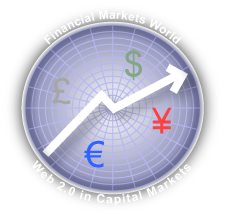Web 2.0 and the Mergers and Acquisitions Industry at the AM&AA reveals how digital social networks are affecting mergers and acquisitions in the mid-market
Reports of “Character Building” Market—Significant Parallels with High Tech Bust—Plus, the Emerging Web 2.0 Vein
 The sub-prime induced correction of the U.S. financial sector has changed the context around M&A during the last year, and mergers and acquisitions experts met last week to share success stories, lessons learned and admonitions at the Alliance of Mergers & Acquisition Advisors Summer Conference July 22-25, 2008 at Chicago’s Wyndham Hotel. I was asked to present a new talk, “Leveraging a Web 2.0 Ecosystem to Grow Your Business,” and I had the opportunity to attend some of the other sessions. I’ll summarize their key points before adding some thoughts on the promise that Web 2.0 and social networks bring to deal marketing due to significantly decreased transaction costs. The sub-prime induced correction of the U.S. financial sector has changed the context around M&A during the last year, and mergers and acquisitions experts met last week to share success stories, lessons learned and admonitions at the Alliance of Mergers & Acquisition Advisors Summer Conference July 22-25, 2008 at Chicago’s Wyndham Hotel. I was asked to present a new talk, “Leveraging a Web 2.0 Ecosystem to Grow Your Business,” and I had the opportunity to attend some of the other sessions. I’ll summarize their key points before adding some thoughts on the promise that Web 2.0 and social networks bring to deal marketing due to significantly decreased transaction costs.
AM&AA members hail from all parts of a rich ecosystem of investment bankers, attorneys, private equity, brokers, intermediaries, CPAs and others who specialize in every […]
Year in Review 2007—Editor’s Choice of the Global Human Capital Journal
 As I reflect on 2007 and create strategy for 2008, several macro-trends come into sharp relief, and I believe that some of them might be helpful to you as you conduct your own planning. As always, I focus on emerging phenomena because they are areas in which disruption and discontinuous change are acting on markets, thereby elevating threats and opportunities. Helping leaders to create strategy to manage the risk of unusual market developments is the focus of my consulting practice. As I reflect on 2007 and create strategy for 2008, several macro-trends come into sharp relief, and I believe that some of them might be helpful to you as you conduct your own planning. As always, I focus on emerging phenomena because they are areas in which disruption and discontinuous change are acting on markets, thereby elevating threats and opportunities. Helping leaders to create strategy to manage the risk of unusual market developments is the focus of my consulting practice.
In 2007 it became clear to me that we were entering a profound social transformation that would produce an unimaginable degree of change. Unlike the technology-precipitated change that I’ve been helping people with since the 1990s, technology is shifting to the background now, and pervasive social change is taking the stage. Look for disruption in all areas affected by how people connect, communicate, purchase and collaborate: business, politics, community and leisure. Moreover, these changes are completely global with all the variations that engenders.
I can’t tell […]
Over-Publicized Problems and Unusual Opportunities—A Way to Monetize Collaboration?
 Financial Markets World held its conference, Web 2.0/Enterprise 2.0 in the Capital Markets Industry, in New York City on 17 September 2007. Invited as a panelist on the bleeding edge track, “Web 3.0: Where Are We Going,” I nonetheless had time to scribble some notes to cover some of the sessions. Financial Markets World held its conference, Web 2.0/Enterprise 2.0 in the Capital Markets Industry, in New York City on 17 September 2007. Invited as a panelist on the bleeding edge track, “Web 3.0: Where Are We Going,” I nonetheless had time to scribble some notes to cover some of the sessions.
Enterprise 2.0 is being adopted by investment banks and the capital markets industry, but adoption is being dampened by two flies in the ointment: 1) the industry is highly regulated, and compliance forces firms to have control of their data, which means CIOs are hesitant to try new technology that may introduce risk; 2) enterprise 2.0 doesn’t yet have a locked and loaded business case. It’s early, and all conference sessions reflected that.
The Global Human Capital Journal’s coverage comprises summaries of all the sessions, as well as more in-depth coverage of three of the sessions. To access all the articles in one click, use the Financial Markets World tag. This article contains the summaries as well as my analysis and conclusions of […]
Adoption Weakened by Compliance Risk and “So Obvious It’s Invisible” Value Proposition
 The Global Human Capital Journal’s coverage of Financial Markets World’s Web 2.0 in the Capital Markets Industry conference continues. In this session, Dion Hinchcliffe, a leading writer and consultant in Web 2.0 and Enterprise 2.0, described how capital markets firms were adopting Enterprise 2.0. After some general points on enterprise 2.0 adoption, he referenced early work of Dresdner Kleinwort, AOL, T. Rowe Price, Wells Fargo and JP Morgan. As usual, I’ll summarize his remarks before sharing my analysis and conclusions. The Global Human Capital Journal’s coverage of Financial Markets World’s Web 2.0 in the Capital Markets Industry conference continues. In this session, Dion Hinchcliffe, a leading writer and consultant in Web 2.0 and Enterprise 2.0, described how capital markets firms were adopting Enterprise 2.0. After some general points on enterprise 2.0 adoption, he referenced early work of Dresdner Kleinwort, AOL, T. Rowe Price, Wells Fargo and JP Morgan. As usual, I’ll summarize his remarks before sharing my analysis and conclusions.
Dion has collaborated repeatedly with O’Reilly, the folks who officially coined the term “Web 2.0” and hold one of its most well attended conferences. He began his presentation with the definition of Web 2.0: (using) “networked applications that explicitly leverage network effects.” In my view, that means purposely leveraging P2P (peer to peer) technology. They scale exceptionally quickly because they are easy to use, people who like to use them do so on their own time and for their […]
Growing Collaboration Culture Will Force Compliance Breakthroughs—Moving to London
 The Global Human Capital Journal’s coverage of Financial Markets World’s Web 2.0 in the Capital Markets Industry conference continues. In this session, Eran Barak, Global Head of Strategy for Reuters, moderated a discussion with panelists David P. Olener, Director Legal Discovery Solutions at Orchestria, and Warren Roy, President & CEO of Global Relay Communications. They are well qualified to discuss this topic: As a former litigator, Olener has extensive experience with complex discovery and has consulted to numerous Fortune 100 clients in compliance, security and risk management. Roy’s company is a hosted compliance archiving and messaging suite used by over 1,200 financial and legal firms for regulatory purposes. The Global Human Capital Journal’s coverage of Financial Markets World’s Web 2.0 in the Capital Markets Industry conference continues. In this session, Eran Barak, Global Head of Strategy for Reuters, moderated a discussion with panelists David P. Olener, Director Legal Discovery Solutions at Orchestria, and Warren Roy, President & CEO of Global Relay Communications. They are well qualified to discuss this topic: As a former litigator, Olener has extensive experience with complex discovery and has consulted to numerous Fortune 100 clients in compliance, security and risk management. Roy’s company is a hosted compliance archiving and messaging suite used by over 1,200 financial and legal firms for regulatory purposes.
Their consensus was that enterprise 2.0, notably IM (instant messaging, chat) introduces significant issues with highly regulated financial services firms. Although this is widely known, many of the details of how the technologies can pose problems were illuminating. We will provide a summary of the panel before adding our insights.
Enterprise 2.0 Technologies and Regulatory Issues IM is […]
A Glimpse Inside the Emerging Divide between Wall Street Professionals—How Many Goldman Employees Are on Facebook?
 The Global Human Capital Journal’s coverage of Financial Markets World’s Web 2.0 in the Capital Markets Industry conference continues. In this session, Tom Steinthal of the BSG Alliance wrapped the conference by crystallizing several Web 2.0 concepts with passion and panache. Tom is Managing Director of BSG Alliance’s Financial Services practice. Previously he has managed equities technology teams at Goldman Sachs, Donaldson, Lufkin & Jenrette, Credit Suisse, JPMorgan Chase and Prudential. Further back, he led Nasdaq technology teams and designed and implemented Nasdaq trade order management and market making systems. He has been a member of various Nasdaq and NASD technology committees and has been Series 7, 3 and 55 licensed. The Global Human Capital Journal’s coverage of Financial Markets World’s Web 2.0 in the Capital Markets Industry conference continues. In this session, Tom Steinthal of the BSG Alliance wrapped the conference by crystallizing several Web 2.0 concepts with passion and panache. Tom is Managing Director of BSG Alliance’s Financial Services practice. Previously he has managed equities technology teams at Goldman Sachs, Donaldson, Lufkin & Jenrette, Credit Suisse, JPMorgan Chase and Prudential. Further back, he led Nasdaq technology teams and designed and implemented Nasdaq trade order management and market making systems. He has been a member of various Nasdaq and NASD technology committees and has been Series 7, 3 and 55 licensed.
Wall Street firms will increasingly get caught up in several threads of culture change, but he emphasized two: the generational divide and, related to it, collaboration vs. control. In this context, “building an enterprise 2.0 system ’employees’ will use” must take into account very different styles of working and […]
Just Released—CSRA Market Advisory Highlights How I-Banks are Using Web 2.0 to Drive Competitiveness
![Enterprise 2.0 A Game-Changer for Investment Banks [Market Advisory]](http://rollyson.net/wp-content/uploads/2007/09/Mkt_Advisory.gif) This summer, “Enterprise 2.0” began to get legs as the new moniker for applying Web 2.0 to the enterprise, reflecting that pragmatists are raising their eyes for an exploratory glance. The market advisory shares how global investment banks are using Enterprise 2.0, and it suggests action steps for executives to take this year and next. Here is the executive summary and a few choice concluding points: This summer, “Enterprise 2.0” began to get legs as the new moniker for applying Web 2.0 to the enterprise, reflecting that pragmatists are raising their eyes for an exploratory glance. The market advisory shares how global investment banks are using Enterprise 2.0, and it suggests action steps for executives to take this year and next. Here is the executive summary and a few choice concluding points:
Enterprise 2.0 Enables Executives to Digitize and Monetize Collaboration for the First Time
This is so simple that many will miss it and open themselves to disruptive competition…
Banks increasingly use wikis, blogs and other Web 2.0 tools for mission-critical processes, as shown through the examples of Citi, DrKW, Morgan Stanley, ING and JP Morgan.. Enterprise 2.0 is a new term that denotes corporate adoption of Web 2.0 and social software tools. It offers investment banks an unusual opportunity to reduce risk and improve their earnings and profits by increasing returns on process, human and knowledge capital. However, Enterprise 2.0 also confronts banks […]
|
|
 The sub-prime induced correction of the U.S. financial sector has changed the context around M&A during the last year, and mergers and acquisitions experts met last week to share success stories, lessons learned and admonitions at the Alliance of Mergers & Acquisition Advisors Summer Conference July 22-25, 2008 at Chicago’s Wyndham Hotel. I was asked to present a new talk, “Leveraging a Web 2.0 Ecosystem to Grow Your Business,” and I had the opportunity to attend some of the other sessions. I’ll summarize their key points before adding some thoughts on the promise that Web 2.0 and social networks bring to deal marketing due to significantly decreased transaction costs.
The sub-prime induced correction of the U.S. financial sector has changed the context around M&A during the last year, and mergers and acquisitions experts met last week to share success stories, lessons learned and admonitions at the Alliance of Mergers & Acquisition Advisors Summer Conference July 22-25, 2008 at Chicago’s Wyndham Hotel. I was asked to present a new talk, “Leveraging a Web 2.0 Ecosystem to Grow Your Business,” and I had the opportunity to attend some of the other sessions. I’ll summarize their key points before adding some thoughts on the promise that Web 2.0 and social networks bring to deal marketing due to significantly decreased transaction costs.
 As I reflect on 2007 and create strategy for 2008, several macro-trends come into sharp relief, and I believe that some of them might be helpful to you as you conduct your own planning. As always, I focus on emerging phenomena because they are areas in which disruption and discontinuous change are acting on markets, thereby elevating threats and opportunities. Helping leaders to create strategy to manage the risk of unusual market developments is the focus of my consulting practice.
As I reflect on 2007 and create strategy for 2008, several macro-trends come into sharp relief, and I believe that some of them might be helpful to you as you conduct your own planning. As always, I focus on emerging phenomena because they are areas in which disruption and discontinuous change are acting on markets, thereby elevating threats and opportunities. Helping leaders to create strategy to manage the risk of unusual market developments is the focus of my consulting practice. Financial Markets World held its conference, Web 2.0/Enterprise 2.0 in the Capital Markets Industry, in New York City on 17 September 2007. Invited as a panelist on the bleeding edge track, “Web 3.0: Where Are We Going,” I nonetheless had time to scribble some notes to cover some of the sessions.
Financial Markets World held its conference, Web 2.0/Enterprise 2.0 in the Capital Markets Industry, in New York City on 17 September 2007. Invited as a panelist on the bleeding edge track, “Web 3.0: Where Are We Going,” I nonetheless had time to scribble some notes to cover some of the sessions. The Global Human Capital Journal’s coverage of Financial Markets World’s Web 2.0 in the Capital Markets Industry conference continues. In this session, Dion Hinchcliffe, a leading writer and consultant in Web 2.0 and Enterprise 2.0, described how capital markets firms were adopting Enterprise 2.0. After some general points on enterprise 2.0 adoption, he referenced early work of Dresdner Kleinwort, AOL, T. Rowe Price, Wells Fargo and JP Morgan. As usual, I’ll summarize his remarks before sharing my analysis and conclusions.
The Global Human Capital Journal’s coverage of Financial Markets World’s Web 2.0 in the Capital Markets Industry conference continues. In this session, Dion Hinchcliffe, a leading writer and consultant in Web 2.0 and Enterprise 2.0, described how capital markets firms were adopting Enterprise 2.0. After some general points on enterprise 2.0 adoption, he referenced early work of Dresdner Kleinwort, AOL, T. Rowe Price, Wells Fargo and JP Morgan. As usual, I’ll summarize his remarks before sharing my analysis and conclusions.